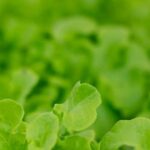Looking to add some greenery to your shaded outdoor space? If so, you’re likely wondering which vegetables to grow in shade gardens. Shade gardening can be both rewarding and challenging, but with the right knowledge and techniques, it’s possible to cultivate a thriving vegetable garden in shaded areas.
In this article, we’ll explore the concept of shade gardens and the benefits of growing vegetables in shaded areas. You’ll learn about different types of shade, how they affect vegetable growth, and the best vegetables for shade gardens. We’ll also provide practical tips on maximizing vegetable growth in shaded spaces, including advice on soil preparation, watering, and plant selection.
Whether you’re a beginner or experienced gardener, this article will equip you with the information needed to successfully grow vegetables in a shaded garden space. From understanding shade to harvesting and maintenance tips, you’ll find everything you need to create a bountiful harvest of fresh, home-grown produce right in your own shaded backyard. Let’s get started.
Understanding Shade
When it comes to shade gardening, understanding the different types of shade and how they affect vegetable growth is crucial for success. Here are some key things to consider when planning a shade garden:
1. Full Shade: This type of shade occurs when plants receive no direct sunlight throughout the day. Vegetables that thrive in full shade include leafy greens such as lettuce, spinach, and kale, as well as root vegetables like carrots and beets.
2. Partial Shade: Partial shade occurs when plants receive varying amounts of sunlight throughout the day, often due to surrounding trees or buildings. Vegetables that can tolerate partial shade include herbs like cilantro, parsley, and mint, as well as certain varieties of tomatoes and peppers.
3. Dappled Shade: Dappled shade occurs when sunlight filters through the leaves of overhead trees or shrubs, creating patches of light and shadow. In dappled shade conditions, leafy greens like arugula and Swiss chard, as well as certain types of radishes and scallions, can thrive.
Understanding these types of shade will help you choose the right vegetables for your specific growing conditions. It’s important to assess the amount and duration of shade in your garden to determine which vegetables will grow best in your particular environment. By selecting the appropriate vegetables for your shade garden, you can still enjoy a bountiful harvest of fresh produce even in lower light conditions.
Best Vegetables for Shade Gardens
When it comes to growing vegetables in shade gardens, it’s important to choose varieties that are well-suited to low light conditions. While many vegetables require ample sunlight for optimal growth, there are several crops that thrive in shaded areas.
Leafy greens such as lettuce, spinach, and kale are excellent choices for shade gardens, as they can tolerate less light than other vegetable varieties. These leafy greens not only grow well in shaded conditions but also offer a nutritious addition to your diet.
In addition to leafy greens, root vegetables like radishes, carrots, and beets are also suitable for shade gardens. These crops focus their energy on developing underground roots rather than foliage, making them more tolerant of lower light levels. By choosing the right varieties and providing proper care, you can still enjoy a bountiful harvest of root vegetables even in shaded areas.
Furthermore, herbs such as mint, parsley, and chives are well-adapted to shade gardens. Many herbs actually prefer some protection from intense sunlight, making them an ideal choice for growing in shaded spaces.
Whether you’re adding flavor to your culinary creations or simply enjoying the aromatic foliage in your garden, these shade-tolerant herbs make a valuable addition to any shade garden. With the wide variety of vegetables that thrive in shaded conditions, creating a productive and visually appealing shade garden is within reach for gardening enthusiasts of all experience levels.
Tips for Successful Shade Gardening
Shade gardening can be a rewarding experience, especially when it comes to growing vegetables. While shaded areas may seem less suitable for plant growth, there are several practical tips that can help maximize vegetable growth in these conditions. One of the key factors to consider is soil preparation.
Since shaded areas typically have less direct sunlight, it’s important to ensure that the soil is well-nourished and healthy to support plant growth. Adding organic matter such as compost or aged manure can help improve soil structure and fertility, providing essential nutrients for the vegetables to thrive.
In addition to soil preparation, proper watering is crucial for successful shade gardening. Shaded areas tend to retain more moisture and may have slower evaporation rates compared to sunny spots. As a result, it’s important to monitor the moisture levels in the soil and adjust watering frequency accordingly.
Overwatering can lead to root rot, so it’s essential to strike a balance and water plants only when necessary. Mulching around the base of plants can also help retain moisture and regulate soil temperature in shaded areas.
When it comes to plant selection for shade gardens, it’s important to choose vegetables that are well-suited for low light conditions. Leafy greens such as lettuce, spinach, and kale thrive in partial shade, making them excellent choices for shaded vegetable gardens. Root vegetables like radishes and beets can also tolerate limited sunlight and are suitable for growing in shaded areas.
Additionally, herbs such as mint, parsley, and cilantro can flourish in shady spots, providing an aromatic addition to your shade garden while also being highly versatile in culinary uses. By selecting the right vegetables for your shade garden, you can ensure a bountiful harvest of fresh produce throughout the growing season.
By following these practical tips on soil preparation, watering techniques, and plant selection, you can effectively maximize vegetable growth in shaded areas. With careful planning and attention to specific needs of shade-tolerant vegetables, you’ll be well on your way to creating a thriving shade garden filled with an abundance of fresh produce.
Whether you’re a beginner or experienced gardener, experimenting with different varieties of vegetables to grow in shade gardens can lead to a successful and enjoyable gardening experience.
Container Gardening in Shade
Benefits of Container Gardening in Shade
Container gardening offers several advantages for growing vegetables in shaded spaces. One of the main benefits is the ability to move the containers to follow the sun throughout the day, maximizing the amount of light that reaches the plants.
This flexibility is especially useful in areas with partial shade, where sunlight may shift during different times of the day. Additionally, container gardening allows for better control over soil and water conditions, which can be crucial for successful vegetable growth in shady environments.
Recommended Vegetable Varieties for Container Gardening in Shade
When choosing vegetables for container gardening in shaded areas, it’s important to select varieties that are well-suited for limited sunlight. Leafy greens such as spinach, lettuce, and kale are excellent choices, as they can thrive with less direct sunlight compared to other vegetables.
Additionally, root vegetables like radishes and carrots can also do well in containers placed in partially shaded locations. Herbs such as parsley, cilantro, and mint are another great option for shade-tolerant container gardening, providing both culinary and aesthetic benefits.
Container Gardening Tips for Shaded Spaces
To ensure success with container gardening in shaded areas, there are several tips to keep in mind. Firstly, choose containers that provide adequate drainage to prevent waterlogging of the soil. Consider using lightweight materials like plastic or resin to make moving the containers easier.
It’s also important to regularly monitor soil moisture levels and adjust watering frequency based on the specific needs of each vegetable variety being grown. Finally, consider placing containers on casters or plant caddies to easily move them throughout the day to capture optimal sunlight exposure.
By utilizing container gardening techniques specifically tailored for shaded spaces, individuals can enjoy a bountiful harvest of fresh vegetables even in areas with limited sunlight. With careful plant selection and proper care, shade gardens can be just as productive and rewarding as gardens located in full sun.
Shade-Tolerant Vegetable Varieties
When it comes to growing vegetables in shade gardens, choosing the right varieties can make all the difference. While some vegetables may struggle in low-light conditions, there are specific varieties that have been bred or naturally adapted to thrive in shaded areas.
These shade-tolerant vegetable varieties are excellent choices for gardeners looking to make the most of their shady spaces and still enjoy a bountiful harvest. Whether you’re a beginner or an experienced gardener, incorporating these vegetables into your shade garden can lead to successful and rewarding results.
Leafy greens such as spinach, kale, and lettuce are among the top choices for shade gardens. These vegetables not only tolerate low light but also benefit from it by staying cooler during hot summer days. They can be grown in both full shade and partial shade, making them versatile options for various types of shaded areas. Additionally, leafy greens are generally quick-growing and can be continuously harvested throughout the growing season, providing a steady supply of fresh produce.
Root vegetables like radishes, beets, and carrots are another group of vegetables that excel in shaded conditions. While they may take longer to mature compared to those grown in full sun, these root crops will still develop well in partial shade.
Choosing quick-maturing varieties is especially beneficial for shaded areas, as they can reach harvestable size within a reasonable timeframe despite limited sunlight. For beginner gardeners looking to experiment with root vegetables in shade gardens, starting with radishes is often recommended due to their easy cultivation and fast growth.
In addition to leafy greens and root vegetables, certain herbs also adapt well to growing in the shade. Examples include mint, parsley, and cilantro – all of which prefer cooler temperatures and can thrive in partially shaded locations.
These herbs not only complement the flavors of shade-loving vegetables but also provide added culinary versatility and aesthetic appeal to the garden. By incorporating these diverse shade-tolerant vegetable varieties into your garden design, you can create a lush and productive oasis even in areas with limited sunlight.
Designing a Shade Garden
Creating Functional Zones
When designing a shade garden for vegetable cultivation, it’s essential to create functional zones that optimize the use of space and sunlight. Consider grouping vegetables according to their light requirements, with leafy greens and shade-tolerant herbs placed in the shadier areas, while root vegetables may be positioned in spots with slightly more sunlight.
By strategically planning the layout of your shade garden, you can ensure that each plant receives the ideal amount of light for healthy growth and productivity.
Incorporating Vertical Elements
In a shaded garden, space is often limited, making it important to utilize vertical elements for growing vegetables. Incorporate trellises, arbors, or vertical gardening structures to support climbing plants such as peas, beans, and cucumbers. This not only maximizes the use of available light but also adds visual interest to the garden design. Additionally, consider utilizing hanging baskets or vertical planters for growing compact varieties of vegetables like cherry tomatoes or trailing herbs.
Choosing Aesthetically Pleasing Varieties
While prioritizing functionality and productivity in shade garden design, don’t overlook the aesthetic aspect of vegetable cultivation. Select visually appealing vegetable varieties with different colors, textures, and forms to create an attractive and diverse garden display.
Incorporating ornamental edibles such as rainbow chard or red-veined sorrel can add a pop of color to shaded areas while providing a bountiful harvest of nutritious produce. By carefully choosing aesthetically pleasing varieties, you can enhance the overall appeal of your shade garden while enjoying an abundance of fresh vegetables.
By carefully considering functional zoning, vertical elements, and aesthetically pleasing varieties when designing a shade garden for vegetable cultivation, you can create an attractive and productive space that delivers a bountiful harvest year after year. Careful planning and thoughtful selection of vegetable varieties will ensure that your shaded garden not only looks beautiful but also provides an abundant supply of home-grown produce throughout the growing season.
Harvesting and Maintenance
Once your shade garden has been established and your vegetables have been planted, it is important to understand when and how to harvest your produce. Harvesting vegetables at the right time ensures that you enjoy them at their peak flavor and nutritional value.
Additionally, ongoing maintenance is crucial for keeping a shade garden productive and healthy. In this section, we will discuss the best practices for harvesting vegetables grown in shade gardens and provide maintenance tips to help keep your garden thriving.
When it comes to harvesting vegetables in shade gardens, timing is key. Leafy greens such as spinach, lettuce, and kale can be harvested when the outer leaves are large enough to eat, allowing the inner leaves to continue growing for future harvests.
For root vegetables like carrots and beets, it’s important to wait until they reach a suitable size before pulling them from the ground. Herbs can be harvested as needed throughout the growing season, ensuring a steady supply of fresh flavors for your culinary creations.
In addition to knowing when to harvest, ongoing maintenance plays a crucial role in the success of shade gardens. Regular watering is essential, as shaded areas may retain moisture longer than sunny spots but still require consistent hydration for optimal vegetable growth.
It’s also important to monitor for pests and diseases that can affect plants in shaded environments. By staying proactive with pest management and disease prevention, you can help keep your shade garden healthy and productive throughout the growing season.
Practicing good soil care is another important aspect of maintaining a thriving shade garden. Adding compost or organic mulch helps maintain soil fertility and retains moisture, creating an optimal environment for vegetable growth in shaded areas. With proper maintenance techniques in place, your shade garden can continue to provide a bountiful harvest of fresh vegetables for you to enjoy throughout the season.
Conclusion
In conclusion, shade gardens offer a unique opportunity to grow a variety of vegetables and herbs, despite the challenges of limited sunlight. Understanding the different types of shade and how they affect vegetable growth is crucial for successful gardening in shaded areas. By selecting the right vegetables for shade gardens, such as leafy greens, root vegetables, and herbs, gardeners can enjoy a bountiful harvest of fresh, home-grown produce.
Additionally, practical tips for successful shade gardening, including soil preparation, watering techniques, and plant selection, can help maximize vegetable growth in shaded areas. For those with limited space, container gardening in shade becomes an attractive option. By choosing the right vegetable varieties and following container gardening tips, individuals can still cultivate a thriving garden in shaded spaces.
Furthermore, embracing shade-tolerant vegetable varieties and designing a well-planned shade garden layout can result in an aesthetically pleasing and productive garden. With proper harvesting and maintenance practices in place, individuals can enjoy the rewards of their efforts by reaping a continuous supply of fresh vegetables from their shade gardens.
Overall, growing vegetables in shade gardens is not only achievable but also rewarding for those who are willing to explore this unique approach to gardening. So don’t hesitate to give it a try.
Frequently Asked Questions
What Vegetables Are Best Grown in Shade?
Some vegetables that thrive in shade include leafy greens like lettuce, spinach, and kale. Other shade-tolerant vegetables include broccoli, cauliflower, and certain herbs like mint and parsley. These plants can handle less direct sunlight and still produce a good harvest.
What Vegetable Needs the Least Amount of Sunlight?
When it comes to vegetables needing the least amount of sunlight, root vegetables like radishes and beets are good choices. These vegetables can tolerate partial shade and still grow well. Additionally, mushrooms are not technically a vegetable but they thrive in low light conditions as well.
Which Plant Grows Best in Full Shade?
If you’re looking for a plant that grows best in full shade, consider options like hostas, ferns, and coral bells (Heuchera). These plants are known for their ability to thrive in shady areas with minimal sunlight. They add lushness and beauty to shaded garden spaces.

If you’re looking to get into vegetable gardening, or are just looking for some tips on how to make your current garden better, then you’ve come to the right place! My name is Ethel and I have been gardening for years. In this blog, I’m going to share with you some of my best tips on how to create a successful vegetable garden.





